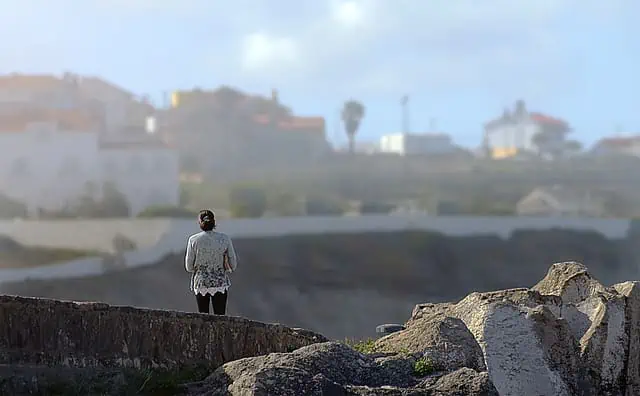Travel Tips
Solo Travel Safety Tips: The Ultimate Guide for Staying Safe on the Road
“Picture this: You’re wandering alone through the enchanting streets of Paris, the sun setting gently above you, casting a majestic glow onto the countless treasures the City of Light beholds. Suddenly, amidst these picture-perfect moments, you realize your wallet has gone missing. Panic sets in, and now what was once a dream vacation has turned into a nightmare. But don’t worry! We’ve got your back with our comprehensive solo travel safety tips—the definitive guide to not only avoiding such catastrophes but also ensuring your solo adventures are as rewarding and safe as possible. Read on to make sure your next journey is one for the books—minus those unexpected hiccups.”

Essential Safety Tips for Solo Travellers
Solo travel can be one of the most rewarding experiences of your life, but it also comes with an increased level of responsibility and safety concerns. Here are some essential safety tips that all solo travelers should keep in mind before they hit the road.
First and foremost, always let someone back home know your itinerary, including your flight details, hotel bookings, and any tours you plan to take. That way, if anything happens along the way, others will know where to look for you. You could also consider using a check-in app that will send your location to friends or family at predetermined times throughout the day.
Secondly, research and learn about the culture and customs of the country you’re visiting before you depart. Understanding local traditions, dress codes, and social practices can help you blend in more easily and avoid unwanted attention.
For example, in some Middle Eastern countries, it is considered disrespectful (and potentially unsafe) for women to show too much skin in public areas. So long-sleeved shirts or T-shirts that cover up to the elbows and long pants or skirts that cover well below the knees are often appropriate attire.
However, blending in doesn’t necessarily mean hiding your identity; it’s possible to dress modestly while also expressing personal style (such as jewelry or scarves).
Thirdly, always carry a photocopy of your passport or ID card with you when you’re out exploring. Leave the original documents in a safe place (like your hotel room’s safe) where they will be less likely to be lost or stolen. You could also consider taking a picture of these documents on your phone or emailing them to yourself as a backup.
I once met a traveler who had her passport stolen while browsing a market in Marrakech. Due to her quick thinking of carrying a photocopy with her, she was able to show it to the police and board her flight home without issue.
Now that you have a few essential tips under your belt, let’s move on to how to protect your valuables and documents while traveling solo.
Protect Your Valuables and Documents
One of the biggest fears for solo travelers is having their valuables stolen. Here are a few tips to keep in mind for protecting your belongings.
Firstly, never carry all your cash or cards in one place. Instead, divide them into different pockets or bags so that if one bag gets lost or stolen, you still have access to some money.
For example, when I was traveling solo in Thailand, I kept one credit card in my wallet, some cash in my purse, and another backup card hidden in my luggage in my hotel room.
Secondly, invest in a good-quality anti-theft daypack. These types of backpacks often come with slash-proof straps, lockable zippers and RFID-blocking technology which prevents scanning of personal details such as passport information.
They also tend to have pockets specifically designed for storing valuable electronics such as laptops or cameras. If you’re carrying around pricey equipment for work or personal use while traveling solo, investing in an anti-theft bag may be well worth it.
Thirdly, always be aware of your surroundings especially when using public transportation or exploring unfamiliar areas. Never leave your belongings unattended or out of sight even for just a few moments.
Think of it like leaving the keys in the car with the engine running; it only takes a moment for someone to take off with everything you own!
Lastly, consider purchasing a travel insurance policy that covers theft or loss of personal property as well as emergency medical coverage.
Recently while traveling solo through Mexico I fell victim to pickpocketing in a crowded market. Fortunately, I had purchased comprehensive travel insurance beforehand which covered the replacement of my stolen items and helped me to feel slightly less stressed about the situation.
Now that you’ve got some valuable tips on how to protect your valuables and documents while solo traveling, let’s focus on other safety measures you can take to avoid high-risk situations.
Avoid High-Risk Situations
As a solo traveler, it’s important to be aware of potential high-risk situations and avoid them as much as possible. While traveling alone can be an exhilarating experience, it’s essential to prioritize safety while navigating new environments.
One of the most critical aspects of avoiding high-risk situations is trusting your instincts. If something feels off or uncomfortable, listen to your intuition and move away from the situation. It’s better to err on the side of caution rather than put yourself in danger.
Another key strategy is to avoid flashing any valuable items such as jewelry or electronics. This includes keeping your phone out of sight when not in use and leaving expensive items at home if possible. By blending in with the local environment and being discreet with your belongings, you can reduce the risk of theft or robbery.
Recently, I was exploring a bustling marketplace in Thailand when I noticed a group of tourists with flashy jewelry and cameras around their necks. It became clear that they were standing out and attracting unwanted attention, making them more vulnerable to potential theft or worse. In contrast, by blending in and staying aware of my surroundings, I was able to navigate the market without incident.
In addition to being aware of yourself and your belongings, it’s also important to research potential high-risk areas before arriving at a destination. This includes identifying neighborhoods known for crime or being cautious when traveling at night. Research travel advisories from trusted sources like government websites or reputable travel blogs to stay informed.
For example, let’s say you’re invited to go bar-hopping with some new friends in a foreign city. Before committing, do some research on the neighborhood where the bars are located and whether it’s safe for travelers at night. Consider on-site reviews as well – what do past visitors say about the area? By doing this research beforehand, you can ensure that you’re having fun while also being responsible and staying safe.
Some travelers may argue that avoiding high-risk situations takes away from the spontaneity and excitement of solo travel. While it’s true that unexpected situations can arise, sticking to basic safety principles is crucial for your overall well-being on the road. By taking these precautions, you’ll be able to enjoy your travels without worrying about unnecessary risks.
Staying Healthy on the Road
Another essential aspect of solo travel safety is staying healthy and taking appropriate health precautions while on the road. This includes everything from maintaining a balanced diet to protecting yourself against common illnesses.
One of the most important rules for staying healthy while traveling is to stay hydrated. Whether you’re trekking through a desert or strolling through a busy city, it’s crucial to drink plenty of water throughout the day. It’s also wise to avoid drinking tap water in certain destinations – always opt for bottled water instead.
On a recent trip to Mexico, I spent an entire day exploring ancient Mayan ruins under the hot sun. Although I was prepared with plenty of sunscreens, I neglected to drink enough water and ended up feeling dehydrated by the end of the day. This taught me an important lesson about prioritizing hydration even during times when I’m caught up in the excitement of exploring new surroundings.
Additionally, maintaining good hygiene practices is crucial for staying healthy on the road. This includes washing your hands regularly and using hand sanitizer before meals and after touching public surfaces like doorknobs or handrails.
For instance, let’s say you’re traveling to a region known for mosquito-borne illnesses like malaria or dengue fever. Precautions such as wearing long-sleeved shirts and carrying mosquito repellent can go a long way in reducing your risk of infection.
Much like how you wouldn’t leave home without a first-aid kit, taking additional health precautions while traveling is just as critical. By prioritizing your health and well-being on the road, you’re investing in a sustainable travel experience that will allow you to make the most of every moment.
Planning Your Solo Trip
Planning a solo trip can be daunting, but it doesn’t have to be if you do your research and plan ahead. Whether you’re an experienced solo traveler or about to embark on your first solo adventure, here are some tips to help you plan your trip.
First, decide on a destination. Consider the culture, language, weather, and cost of living. Do some research online, read travel blogs or guidebooks, and ask friends who have traveled to the same destination for their recommendations. Once you’ve decided on a location, create an itinerary that includes landmarks or attractions you want to visit.
Think of your itinerary as a rough draft. You should allow for flexibility in case your plans change unexpectedly. However, it’s crucial to schedule some downtime during your trip so you can relax and explore the area without feeling rushed.
Next, book your accommodations and transportation in advance through reputable websites or apps. This way, you won’t have to worry about finding lodging at the last minute or navigating unfamiliar public transportation.
When booking accommodations, consider whether you want to stay in a hostel for socializing with other travelers or opt for a private hotel room for peace. Be sure to choose safe neighborhoods within proximity to public transport or attractions on your itinerary.
Now that we’ve covered planning your trip let’s move on to researching destinations and local customs.
Researching Destinations and Local Customs
Researching destinations and local customs is crucial for staying safe while traveling solo. Before departing for a destination:
Check your government’s website for travel alerts and safety advisories relevant to your intended destination. Keep up-to-date with current news related to politics, weather patterns, crime rates, and potential natural disasters before booking airline tickets or hotels. Understanding your destination and researching any potential safety risks is crucial for staying safe.
Avoid looking like a tourist or drawing attention to yourself by learning about the local customs and cultural norms. Demonstrating respect for local etiquette can help you avoid misunderstandings, conflicts, or even arrest. For example, in some countries, it’s not appropriate to show affection towards your significant other in public spaces.
In addition, research the best mode of transportation when navigating local areas. Some destinations have hard-to-navigate roads with no clear signage or poorly lit street corners at night. Depending on the country, taxis are cheaper than renting a car while in others taking trains is the most efficient mode of travel.
When traveling solo, register with your government as a citizen traveling abroad and leave copies of your itinerary and passport with family and friends before leaving. This way, they can keep track of your whereabouts in case of an emergency.
By thoroughly researching your destination and learning about local customs, you’ll be better equipped to adapt to new environments on the road. Think of it as studying for an exam. The more preparation you do beforehand, the less overwhelmed you will feel.
Armed with the knowledge and preparation skills just learned we can now discuss how adapting to new environments can enhance our solo travels.
Adapting to New Environments
Adapting to new environments when traveling solo can be daunting, but it is an essential aspect of traveling safely. Being open-minded and flexible will help you navigate foreign cultures and customs with ease.
One of the best ways to adapt to a new environment is to observe how locals behave and try to emulate their actions. For example, if you are in a conservative country where modest dress is expected, wearing revealing clothing could attract unwanted attention. Instead, try dressing more conservatively and blending in with the locals.
Another way to adapt to a new environment is by learning a few basic words and phrases in the local language. Even if your pronunciation isn’t perfect, making the effort to speak the language can go a long way in breaking down cultural barriers and showing respect for the local culture.
Some travelers may argue that it’s difficult to adapt to a new environment without losing their sense of self or individuality. However, adapting to new customs doesn’t mean sacrificing one’s own beliefs or values. It means being respectful of cultural differences and finding common ground with people from different backgrounds.
Adapting to new environments can also be compared to learning how to swim in different types of water. Just as swimming in a pool requires different skills than swimming in the ocean, adapting to a new culture requires different strategies than adapting to a new city or town. Being adaptable and resourceful will help you navigate these variations smoothly.
With these tips in mind, adapting to new environments can be an enjoyable part of your solo travel experience. But blending in is only half of the equation – gaining cultural insight is just as important.
Blending in and Gaining Cultural Insight
Blending in with locals helps avoid drawing unwanted attention, but gaining cultural insight takes it a step further by enhancing your travel experiences. These tips will help you immerse yourself in local culture while still staying safe.
One way to gain cultural insight is to participate in local activities. This could be anything from taking a cooking class to attending a music festival. Not only will you get to experience the local culture firsthand, but you’ll also have an opportunity to meet locals and make meaningful connections.
Another way to gain cultural insight is by visiting museums or historical sites. By learning about the local culture and history, you’ll gain a better understanding of what makes that community unique. It can also give you context for why certain customs exist and how they’ve evolved over time.
Some solo travelers may argue that it’s safer to stick with more touristy activities, rather than immerse themselves in local culture. While there is some truth to this, it’s important to remember that tourist destinations can also attract pickpockets and scam artists. With research and preparation, it’s possible to safely participate in local activities and cultural events.
Gaining cultural insight can be compared to trying different spices in a dish. Just as different spices can enhance the flavor of a meal, experiencing different cultures can enhance your travel experiences.
By adapting to new environments and gaining cultural insight, you’ll not only stay safe but also embrace the true essence of solo travel. Remember – traveling alone doesn’t mean being alone – it means being open to new experiences and making meaningful connections with people around the world.

Leveraging Technology for Safer Travel
In today’s day and age, technology has revolutionized the way we travel. From finding the best flight deals to booking accommodations and even navigating unfamiliar destinations, there is a wealth of information available at our fingertips. But did you know that technology can also be used to enhance your safety when traveling solo? In this section, we will explore some tips for leveraging technology for safer solo travel.
One of the most important things you can do before embarking on a solo trip is to invest in a quality smartphone with reliable cellular service or Wi-Fi access. A smartphone can be an invaluable tool when it comes to staying connected with loved ones back home and accessing helpful travel resources such as maps, translation apps, and weather updates. You may also want to consider downloading safety-based apps like bSafe or RedZone which offer panic button features, real-time location tracking, and emergency alerts in case of danger.
Along with having a smartphone handy, other technological tools can help keep you safe while solo traveling. Some hotels now offer smart room keys which allow guests to unlock their doors using their smartphones instead of traditional keycards that could easily get lost or stolen. Wearable technology such as smartwatches with GPS tracking capabilities can also be useful in emergencies where you need quick access to your location.
While technology can certainly aid in enhancing safety measures for solo travelers, some people argue that relying too heavily on gadgets can lead to complacency and decreased situational awareness. It’s important to remember that no amount of technology is a substitute for common sense and good judgment when it comes to personal safety. At the end of the day, it’s up to each traveler to use their discretion when incorporating technology into their solo travel plans.
Think of technology as just another tool in your safety toolkit. Just like a first aid kit or a self-defense class, technology can be used to supplement your safety awareness and precautions. It’s important to choose the right tools for your specific needs and research thoroughly before relying on any one gadget or app for complete protection.
Overall, leveraging technology for safer solo travel can be a great way to enhance your travel experience while keeping yourself protected. From smartphones to smart room keys and wearable gadgets, there are endless options available for travelers looking to stay safe on the road. Keep in mind that no technology is foolproof, but with careful research and planning, you can create a tech-based plan that works well for you and your travel goals.
- According to a survey conducted by Solo Traveller in 2021, 56% of respondents reported having taken at least one solo trip in the past year, indicating an increasing trend in solo travel.
- A study by Recreational Tourism Research in 2023 found that among those who traveled solo, 65% engaged in activities specifically aimed at improving their personal safety while traveling.
- In a 2022 study published in Tourism Management Perspectives, it was reported that over 52% of solo travelers used mobile apps during their trips to facilitate navigation, manage accommodations, or join group activities to minimize risks associated with traveling alone.
Solo travel can be an amazing and transformative experience, but it’s essential to prioritize safety along the way. By following these solo travel safety tips, you can minimize risks and ensure that your solo adventures are as rewarding and safe as possible.
From letting someone back home know your itinerary to protecting your valuables and documents, avoiding high-risk situations, staying healthy, planning your trip, researching destinations and local customs, adapting to new environments, gaining cultural insight, and leveraging technology for safer travel, each of these tips contributes to a comprehensive approach to solo travel safety.
Remember, safety should never compromise your ability to enjoy and explore new places. With careful planning, preparation, and awareness, you can embark on incredible solo journeys with confidence and peace of mind. So pack your bags, embrace the world, and make unforgettable memories on your solo travel adventures! Reach out to Vibe Getaways today to know more about planning your next solo vacation! Contact us.
More Articles
How to Master the Pickleball Dink Shot: Effective Techniques and Tips
Pickleball is not just a game; it’s a thrilling mix of strategy, agility, and precision that keeps players on their…
Read MoreBest Warm-Up Exercises for Pickleball Players: A Complete Routine for Optimal Performance
Warm-ups aren’t just about stretching; they’re your secret keys to unlocking peak performance on the pickleball court. Imagine walking into…
Read MoreWhat To Expect At Your First Pickleball Tournament: Tips for Beginners
If you’ve found yourself drawn to the fast-paced, fun-filled world of pickleball, you’re not alone! As pickleball continues to grow…
Read MoreCommon Pickleball Mistakes and Strategies to Fix Them
Pickleball is more than just a fun pastime; it’s a fast-paced sport that offers an exciting combination of strategy, skill,…
Read More


